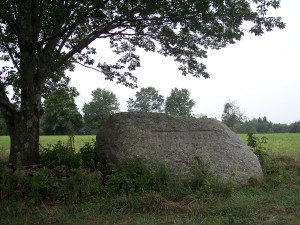With its pastoral vistas, West Brookfield’s Foster Hill today is one of a diminishing number of surviving “heirloom” Massachusetts landscapes. It also is the site of a number of events important in Massachusetts history, at least one of which belies its present day perception of enduring tranquility.
Viewing the five marked historic sites as you proceed from west to east along Foster Hill road your perspective is focused sequentially back in time. The Foster Homestead site (1735) and Whitefield Rock (1740) are early eighteenth century, the last three sites (#3, #4, #5) mark the late seventeenth century Quaboag Plantation years from 1665 to 1675.
There are three additional locations important to the history of the Foster Hill area:
Plantation Burial Ground circa 1670 Sections of the “New” Bay Path (or “Military Road”) 1673 The Town Pound circa 1720
Unfortunately these last three sites are not conspicuous or readily accessible from the road.
Jedediah Foster and the Massachusetts Constitution
At the top of Foster Hill (coming from the west) is a lawn area with a marker stone and an information board which designates the site of the Foster Homestead. This is where the first draft of the Massachusetts Constitution was written by Judge Jedediah Foster in 1779. Much of the wording and content of the Massachusetts Constitution was utilized in the writing of the United States Constitution in Philadelphia in 1787.
Jedediah Foster served as a Representative in the Massachusetts Legislature from 1761 until 1779. Foster and fellow townsman William Ranger were the first in the area to volunteer for an inoculation against small pox, thereby lessening the fears that their fellow townspeople may have had about such a new means of combating this dread disease.
Judge Foster served as a colonel in the Revolution and was a member of the Provincial Congress. The Foster house burned in 1901.
Whitefield Rock – Site #2
On the sixteenth of October in the year 1740 the touring evangelist preacher Reverend George Whitefield gave one of his rousing sermons from a large rock upon Foster Hill to at least four to five hundred people. Considering that this pasture was located in the heart of a still thinly settled region, this eighteenth century gathering must indeed have been a notable event.
Whitefield, whom along with the Wesley brothers, founded Methodism in England in 1738. He also espoused the Calvinist doctrine of predestination which was to eventually alienate him from the Wesleyan Methodists. Whitefield was popular in western Massachusetts during the 1740’s as was the “Great Awakening” a Calvinist revival promoted in part by the sermons of the noted Northampton Evangelist Jonathan Edwards.
Quaboag Plantation – Sites #3, #4 and #5
In late summer of 1665, acting upon a five year old land grant, the: Warner, Prichard, Younglove, and Wilson families from Ipswich along with Thomas Parsons from Windsor, Connecticut, were the first settlers of European origin to take up plots of land in what was designated to become “Quaboag Plantation”. The settlement spread easterly from the west end of Foster Hill as new families arrived in the following years. In 1673 the settlement was deemed large enough to be incorporated and the name was changed to “the Town of Brookfield”.
At this time the mood of the New England native peoples with regard to the Europeans was changing from hospitable to hostile. This tension between the two cultures grew into the violent conflict to be known as “King Philip’s War”.
On August 2, 1675 the isolated town of Brookfield came under siege by the local Indians. Most of the inhabitants took shelter in the fortified Tavern (site #5) leaving their empty homes and outbuildings to be burned by the attackers. The new Meeting House (site #3) was destroyed also. The Indians then directed their attack from a large rock (site #4) that overlooked the besieged Tavern from the south. At one point they managed to set the Tavern afire but a fortunate “thunder shower” put out the fire saving the Tavern’s embattled defendants. The siege lasted three days until the ninety nine people in the beleaguered building were rescued by troops arriving from Marlborough.
The destroyed town of Brookfield was abandoned and it was forty three years before the General Court of Massachusetts Bay Colony again authorized it’s re-incorporation.
Please be advised that the Foster Hill area is private property.
Please respect any “No Trespassing” signs.
Copyright 2001 West Brookfield Historical Commission Last Modified: October 02, 2007
